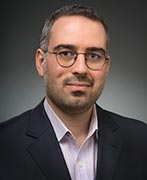CV: Dr. Ali Sadeghi-Naini
By Eleni Kanavas
Bio basics: A scientist in Physical Sciences and the Odette Cancer Research Program at Sunnybrook Research Institute (SRI), and an assistant professor in medical biophysics and radiation oncology at the University of Toronto. Completed a postdoctoral fellowship in medical biophysics and radiation oncology at U of T; a PhD in biomedical engineering at Western University; and a M.Sc. in artificial intelligence at Tehran Polytechnic University in Iran. Born and raised in Tehran, Iran; moved to Canada in 2007 and joined SRI in 2011. Resides in Maple, ON, with his wife, son and daughter.
How does it feel to be appointed a scientist at SRI after having been a postdoc here?
It’s interesting to start your career as a scientist because you can explore your ideas and use all the facilities available to address real-world challenges. I really enjoy analyzing a complication, coming up with ideas, and then designing and implementing a solution. Going through this path is motivating for me in applications where a solution can eventually save patients' lives.
What is your research focus?
I’m conducting research to develop computer-assisted image-guided technologies to improve cancer therapeutics. My research is focused on multimodal cancer imaging to characterize a tumour during its life cycle from various perspectives, and to facilitate planning and navigating of interventional procedures such as biopsy, brachytherapy and radiation therapy.
Why is your research important?
It’s important to identify different stages during tumour formation and its degeneration in response to treatment. Different imaging modalities can help us to recognize these stages based on tumour macrostructure, metabolism and physiology. First, we can characterize the tumour and help a clinician to decide how to treat it. Then, we can evaluate if a tumour is responding to a predefined treatment or not. Noninvasive response evaluation can help a clinician to adjust the treatment on an individual patient basis or even switch to a salvage therapy before it’s too late.
Why did you pursue a career in research?
It was always hard for me to choose between engineering and medicine. That’s why I decided to work within the overlapping area of physical sciences and engineering on one side, and biology and medical sciences on the other. I use my expertise in artificial intelligence and engineering to solve complicated problems in medical sciences.
What drew you to SRI?
SRI provides state-of-the-art facilities in the overlapping areas of research that I’m interested in, and since it’s a hospital-based institute, you have access to clinicians. You also have an opportunity to translate your research into clinic and see real-life changes. During my postdoctoral work with Dr. Gregory Czarnota I had the opportunity to interact with numerous clinicians and scientists in both physical sciences and the Odette Cancer Centre. It was a valuable experience and I’m looking forward to collaborating with all of them in different projects and applications.
How do you maintain a work-life balance?
I have two young kids, so most of my time out of the lab is spent with my family. If weather permits, we go for a picnic and camping, or sometimes biking.






